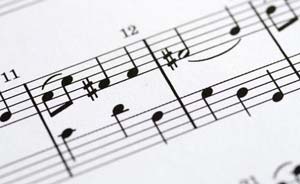
By Ed Malaker
Posted 07/18/2012
To understand the relationship between relative major and relative minor keys, we’ll start with Western tonality, in which we use a system of “keys.” Each key has a number of associated sharps or flats that comprise the overall seven-note structure of the key. The exception is C-Major, which has no sharps or flats. An easy way to visualize C-Major is to imagine playing only the white keys on a piano. All of these white keys are in the key of C-Major. Every other key utilizes at least one of the black keys, meaning that they have at least one sharp or flat note.
In the same manner, every minor key uses one or more sharps or flats. The exception is A-Minor, which, like C-Major, has no sharps or flats. If you imagine that same piano, and play only the white keys, you’re playing in A-Minor. The logical question is: “Well, if I play only the white keys on a piano, am I playing in C-Major or A-Minor?” The answer is: You are playing in both keys.
Short Answer
Every major key has a “relative minor” key that uses the exact same seven notes. Conversely, every minor key has a “relative major” key that uses the exact same seven notes.
So, the next question might be: “Should I even care about this?”
The answer is: “Definitely”
Digging Deeper
Don’t worry, I have good news, and better news. First the good news: It’s insanely easy to determine the relative major and relative minor keys on a guitar. Can you count to “three?” If so, great. If you need to know the relative minor key of a major key, just pick a note on the fretboard that represents the root note of your major key. I always envision the low-E string as it is simplest to view in one’s mind.
Okay, so if you are in the key of A-Major, picture the “A” note on the 5th fret of the low-E string. Now count down three frets. Three frets down from the 5th fret is the 2nd fret. The 2nd fret on the low-E string is “F#”. So, “F#-Minor” is the “relative minor key” of A-Major. This means that if your band is playing in F#-Minor, you can play any note in A-Major. Conversely, if your band is playing in A-Major, you can play any note in F#-Minor.
New Sounds
The better news is that once you internalize the relationship between relative major and relative minor keys, you have a tool that really allows you to broaden your palate a bit. For example, in my mind, when a band is playing in a major key and I have to solo, I always feel that it is a bit boring to solo in a major scale against the same major key. So I immediately think “relative minor” and solo in F#-Minor.
Not every single note sounds perfect all the time, but with a little practice, you can really develop a library of scales and patterns based on a relative minor key. I believe that when you use the relative minor scale to solo against a major groove, it immediately takes on a bit more of a “modal” sound. Once you can really switch back and forth between the major scale and the relative minor scale when you solo, you’ll really notice a difference in the many different “moods” that you can create using this approach.
Improved Chord Vocabulary
Even better news: This technique can really open up doors with regard to your chord work. Imagine again that the band is playing a groove in A-Major. If they are grooving on a A-Major chord, they are grooving on “the one” or “the tonic.” This can get very boring very fast if you are only playing an A-Major chord over the groove. So, play the relative minor chord! Against that A-Major groove, an F#-Minor can sound very cool when voiced right.
Imagine that you are playing an A-Major root-position cord as follows: D-string: 7th fret, -D-string: 6th fret, B-string: 5th fret. Add the G# on the high E-string (4th fret). You now have an F#-m9 chord. Tell me that does not sound much, much cooler than just playing an A-Major chord. The best voicing for this chord would be to eliminate the A note (D-string, 7th fret). So, now you are playing only C#, E, G#. This is not only the top portion of an F#-m9 chord, but it is also a root position C#-Monor chord.
Summary
What I hope is becoming apparent at this point, is that when you start to examine the relationship between the relative major and relative minor keys, you will realize that there are all kinds of relationships between different chords that enable you to quickly develop alternate chord voicings that will not only help to liven up a boring groove, but will also allow you to you develop a broad range of sounds that you can use in solos or chords that become your tool-set.
